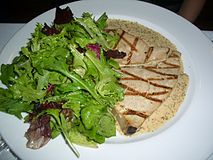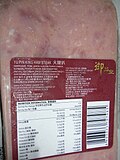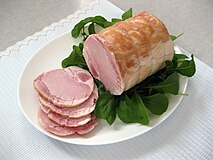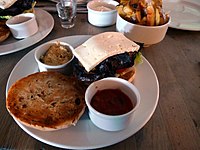Steak
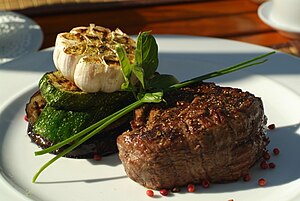
| Part of a series on |
| Steak |
|---|
A steak is a cut of meat sliced perpendicular to the muscle fibers. When the word "steak" is used without qualification, it generally refers to a beefsteak. In a larger sense, there are also fish steaks, ground meat steaks, and so on.
As a "top-quality ingredient" beef steaks "are perfect if properly grilled"[1] but they can be pan-fried, or broiled. Grilling a steak often attempts to replicate the flavour of steak cooked over the glowing coals of an open fire.[1] Steak can also be cooked in sauce, such as in steak and kidney pie, or minced and formed into patties such as hamburgers. A steak differs from a meat chop in that a chop usually contains a rib.
"Steaks" are also cut from grazing animals, usually farmed, other than cattle, including bison, camel, goat, horse, kangaroo, sheep, ostrich, pigs, reindeer, turkey and deer, as well as various types of fish, especially salmon. Some cured meat, such as gammon, is commonly served as steak. The trade in steaks from bushmeat is a serious threat to biodiversity.[2]
Grilled Portobello mushroom may be called mushroom steak and similarly for other vegetarian dishes.[3] Imitation steak is a food product that is formed into a steak shape from various pieces of meat, while fruits such as watermelon can be grilled and described as "watermelon steak" because of their shape and colour.
Etymology
The word steak originates from the mid-15th century Scandinavian word steik or stickna' in the Middle English dialect along with the Old Norse word steikja.[4] The Oxford English Dictionary's first reference is to "a thick slice of meat cut for roasting or grilling or frying, sometimes used in a pie or pudding; especially a piece cut from the hind-quarters of the animal." Subsequent parts of the entry, however, refer to "steak fish" which referred to "cod of a size suitable for cutting into steaks" and also "steak-raid" which was a custom among Scottish Highlanders of giving some cattle being driven through a gentleman's land to the owner.[5] An early written usage of the word "stekys" comes from a 15th-century cookbook, and makes reference to both beef or venison steaks.[6]
Production
Livestock for meat to be used as steak cuts may be raised on a farm or ranch. The meat from various wild game may also be used for steak cuts.
-
A sheep ranch (Estancia) in Argentina
-
Fish farming in Vietnam. Houseboat rafts with rearing cages underneath.
Marketing and sales

Countries with enough suitable land for grazing animals, in particular cattle, have a history of production and culinary use of steak. Such countries include especially Argentina, Ireland, New Zealand, South Africa, the United States and the United Kingdom. In Asian countries, such as China and Korea, steak is traditionally more often sliced and stir-fried and served in smaller amounts as part of a mixed dish.[7]
Argentina
In Argentina, beef represents a large portion of the country's export market. A total of 11.8 million animals were slaughtered in 2010. The country has one of the largest consumptions of beef per capita worldwide,[8] and much of it is barbecued steak. Beef steak consumption is described as part of the "Argentine national identity".[9] In 2010, there were 244,000 cattle producers in Argentina.[10] In Argentina, a steakhouse is referred to as a parrilla, which are common throughout the country.[11] Portion sizes of steak dishes in Argentine restaurants tend to be large, with steaks weighing over 454 grams (one pound) being commonplace.[12] Asado is a traditional dish that often includes steak and is also the standard word for "barbecue" in Argentina and other countries. Asado is considered a national dish of the country.[13]
Australia
Domestic and international marketing of Australian beef is undertaken by Meat & Livestock Australia, a corporation which runs programs related to quality assurance, sustainable production and environmental considerations, through organisations such as Meat Standards Australia (MLA).[14]
Ireland
The Irish agricultural beef market is a contributor to the economy of Ireland. A significant amount of Irish beef is exported to other countries, with over 50% of exported beef going to the United Kingdom.[15]
New Zealand
The "Steak of Origin" competition has been run for a decade on behalf of the Beef+Lamb Corporation of New Zealand. It "aims to find the most tender and tasty sirloin steak" in the country. Criteria for judging include "tenderness, pH, marbling and % cooking loss" as well as taste.[16]
South Africa
South Africa uses steak to create biltong, a popular and exported dried and cured form that has found a market in many beef-eating countries.
United Kingdom
In the United Kingdom, steak is often served with chips and various vegetable accompaniments.
According to a survey by trade magazine Caterer and Hotelkeeper, the most popular dinner menu in British restaurants in the 1980s included steak: being prawn cocktail, steak and Black Forest gateau.[17]
Cattle breeds such as Hereford or Aberdeen Angus, date back to the 1700s and a handful of farmers continue to raise cattle sired by registered pedigree bulls. Bullocks, which live outdoors year-round, grow slowly as they would in their natural habitat, ultimately producing a distinctly tender meat.[18] Around 2,200,000 cattle are slaughtered for beef each year in the United Kingdom.[19]
United States
In the United States, cuts of beef for retail sale include various beefsteaks, as well as stew meat and hamburger meat.[20] In the U.S. circa 1956, approximately 24% of retail beef cuts were beef steaks.[20]
Beef production is the largest single agriculture in the United States with 687,540 farms raising cattle and over a million in the production process as of the 2007 Agriculture Census. On average, a single farm typically raises about 50 cattle at a time with 97 percent of the cattle farms classified as one of these small family farms. These smaller farms average a gross cash income of $62,286 per year as of 2007.[21][22]
Cooking

A grilled steak should no more be kept waiting than should a soufflé or an omelette. Elizabeth David[23]
Beef steaks are commonly grilled, broiled or occasionally fried. Grilled beef steaks can be cooked at different temperatures, or for different lengths of time; the resulting cooked steak ranges from blue (very rare) to overdone. The most common characteristics of a rare steak is a soft, cold, red center. The outside is seared to retain the juices while the inside is cooked to suit the diner's preference. Steaks cooked well-done are typically cooked throughout the entire cut of meat. For example, a beefsteak cooked well-done will not have any pinkness in the middle when sliced. Uncooked beef steak can be served raw, such as in steak tartare.
Fish steaks are generally cooked for a short time as the flesh cooks quickly, especially when grilled. Fish steaks, such as tuna, can also be cooked to various temperatures, such as rare and medium-rare.[24]
The cuts of steak are quite dissimilar between countries owing to the different ways of cutting up the carcass, with the result that a steak found in one country is not the same as in another, although the recipes may be the same, differing "only in their sauces, butters or garnitures".[25]
Dining
French steak cuts as found on menus
- Entrecôte: rib steak, cut from the fore and wing end parts of the rib-roast sections, ribs 9-11
- Romsteck or Rumsteck: rump steak cut from the part of the rump which faces the large end of the filet. Need to be best quality, well-aged.
- Faux filet or Contre fillet: the boneless uppercut of the loin, corresponding to the larger, less tender part of a porterhouse or T-bone steak
- Bifteck: cut from the larger less tender end of the fillet, or any lean, boneless steak from a reasonably tender part of the animal
- Châteaubriand: corresponds to the undercut or fillet portion of a porterhouse steak.[25]
Down on the place d'Armes near Racouchot's, there was a restaurant ...the Pré Aux Clercs ... [that] made very good grilled rare steaks with watercress, which at that time were beginning to be in great vogue in the big cities among the younger generation ...les sportifs... but were dismissed with impatient disgust by older gourmands raised in the intricate traditions of fine sauces and culinary disguise. It was like the Chateaubriant at the other end of the town, also known mostly for its steak and watercress and french fries. M. F. K. Fisher, writing about dining in Dijon in 1929.[26]
Steak has become a popular dish in many places around the world, cooked in domestic as well as professional kitchens and is often a primary ingredient in a menu. It is used in small amounts in an hors d'oeuvre, in an entrée dish or more usually, in a larger amount as the main course. A steak knife is a specialised piece of cutlery to make cutting the steak easier. It is sharper than other knives and has a serrated edge. Steak has also been an important breakfast dish especially for people undertaking hard outdoor work, such as farmers.[27] When ordering steak at a restaurant it is common practice to advise the chef or person taking orders of how you would like your steak cooked. The terms rare, medium-rare, medium, medium-well or well-done denote individual preferences. Print references to the word "rare" go back at least to the 17th century (c)1615).[28]
Steak clubs


Beefsteak Clubs were once part of London's club life. They were described as "a club of ancient institution in every theatre; when the principal performers dined one day in the week together (generally Saturday), and authors and other geniuses were admitted members."[29] Dr Johnson's club in Ivy lane was originally a Beef-Steak Club and the "Rump-Steak or Liberty Club" was in existence from 1733–34.[29] The present-day Beefsteak Club, established in 1876, is at 9 Irving Street, London. Among its members are many notable people.
Steakhouses
A steakhouse is a restaurant that specializes in beefsteaks and other individual portions of meat. Chophouses started in London in the 1690s, and served individual portions of meat, known as chops.[30] The houses were normally only open for men: for example, women were only admitted to Stone's Chop House in 1921.[31][32] Accounts of travellers in 19th century London refer to their "dining off mutton chop, rump steak and a 'weal' cutlet", as well as hams and sirloins.[33]
Delmonico's restaurant in New York City, which opened in 1827 and stayed open for almost 100 years, has been described as "the most famous steak restaurant in American history".[34] Delmonico steak refers to a method of preparation from one of several cuts of beef (typically the rib cut) prepared Delmonico style, originally from the mid-19th century.[35]
Hundreds of restaurants continue to specialize in serving steak, describing themselves as "steakhouses", competing for culinary awards and aiming for culinary excellence.
Sauces and condiments
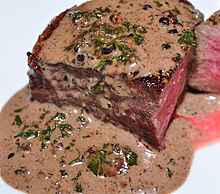
Classic sauces and seasonings to accompany steak include:
- Béarnaise sauce
- Café de Paris sauce
- Compound butters such as parsley butter (to create Entrecôte à la Bretonne), garlic butter or snail butter
- Demi-glace, a rich brown sauce in French cuisine used in the preparation of Tournedos Rossini
- Mustard is a perennial favourite accompaniment for steak
- Pepper, to create Steak au poivre
- Peppercorn sauce
- Sauce Nivernaise
- White wine, to create Tournedos au vin blanc
- Worcestershire sauce, a traditional commercial condiment
Commercially produced bottled sauces for steak and pre-mixed spices are also popular. In 2012 in the U.S., A1 Steak Sauce had slightly over 50% of the market share for all meat sauce products, and was the category leader.[36] Montreal steak seasoning is a spice mix used to flavour steak and grilled meats that was based on the pickling dry-rub mix used in preparing Montreal smoked meat.[37]
Cultural significance

Steak and other meat products can now be frozen and exported, but before the invention of commercial refrigeration transporting meat over long distances was impossible. Communities had to rely on what was locally available which in turn determined the forms and tradition of meat consumption. Hunter-gathering peoples cut steaks from local indigenous animals. For example, Sami cuisine relies partly on the meat of the reindeer; the Inuit diet utilises locally caught sea-mammal meat from whales; Indigenous Australians ate kangaroo, while indigenous North American food included bison steak. In the Middle East, meat recipes from medieval times onwards simply state "meat" without specifying the kind or the cut and "apart from an occasional gazelle, kid or camel", only lamb and mutton were eaten because cattle were seldom bred.[38]
In contemporary Argentina, where consumption of steak is very high,[8] steak is a significant part of the national cuisine and the barbecue asado has the status of a national dish. In Austria, the national dish is Wiener Schnitzel, which is a type of steak made from veal. Advice on butchery and recipes for American black bear steak and chops is provided by US governments.[39]
Religious observance has an effect on the consumption of steak and other meats. Christians give up steak, but not fish, for Lent and during the Friday Fast.[40] Jews and Muslims are not permitted to eat pork steak; and for many Hindus, cows are sacred and should not be killed or eaten.
Beefsteak
- See also: Meat hanging, Beef aging and Cut of beef
Many types of beefsteak exist. The more tender cuts of beef, from the loin and rib, are cooked quickly, using dry heat, and served whole. Less tender cuts from the chuck or round are cooked with moist heat or are mechanically tenderized (e.g. cube steak). Beef steak can be cooked to a level of very rare (bleu, a cold raw center), rare, medium rare, medium, medium well done, or well done. Pittsburgh rare is charred on the outside. Beef, unlike certain other meats, does not need to be cooked through. Food-borne human illnesses are not normally found within a beef steak, though surfaces can potentially be contaminated from handling, and thus, very rare steak (seared on the outside and raw within) is generally accepted as safe.
Beef steak is graded for quality with higher prices for higher quality. Generally, the higher the quality, them more tender the beef, the less time is needed for cooking, or the better the flavour. For example, beef fillet is the most tender[41] and wagyu, such as Kobe beef from Japan, is known for its high quality and commands a high price.[42] Steak can be cooked relatively quickly compared to other cuts of meat, particularly when cooked at very high temperatures, such as by broiling or grilling.
The quality and safety of steak as a food product is regulated by law. In Australia, there are National Meat Accreditation standards;[43] in Canada, there is the Canadian Beef Grading Agency;[44] in the United Kingdom, the Food Standards Agency is responsible;[45] and in the United States, beef is graded by the United States Department of Agriculture (USDA) as select, choice or prime,[46] where "prime" refers to beef of the highest quality, typically that which has significant marbling.[46] In 1996 in the U.S., only 2.4% of cattle were graded as prime,[47] and most prime beef is sold in restaurants and hotels.[46]
-
Inspected beef carcasses tagged by the USDA
-
High grade sliced Matsusaka wagyu beef (rib section meat)
-
Matsusaka sirloin steak
There is a wide range of quickly prepared and well-known beef steak dishes including Minute steak, steak sandwiches, steak and eggs. "Surf and turf", which combines meat and fish requires more time to prepare. Steak meat is also often minced, shredded, chopped finely or re-formed to create a range of dishes including steak burger that retain the name "steak". Other such dishes include:
- Chicken fried steak – a breaded cutlet dish consisting of a piece of steak (tenderized cube steak) coated with seasoned flour and pan-fried. It is associated with U.S. Southern cuisine.
- Hamburg steak – a beefsteak that is shaped into a patty to be cooked after being minced. It is closely similar to the Salisbury steak. Made popular worldwide by the migrating Germans, it became a mainstream dish in around the start of the nineteenth century.
- Restructured steak – a class of imitation beef steaks made from smaller pieces of beef fused together by a binding agent. Its development started from the 1970s.
- Salisbury steak, first recorded in 1897 and named after James Salisbury, a doctor during the American Civil War, who recommended people eat hamburger three times per day. During World War I, American solders replaced the word "hamburger" with Salisbury steak for political reasons.[48]
Fish steak
Fish steaks are cut perpendicular to the spine and include bones. Although their delicate flesh requires quicker cooking than beef, steaks from swordfish, halibut, tuna, salmon and mahi-mahi can be grilled. They are frequently cooked whole or as fillets. Fish steaks may also be poached or baked using a court bouillon, wine or sauce or cooked en papillote.[49]
Commercial sashimi tuna steaks may have their coloration fixated by the use of flushing with carbon monoxide (CO), whereby CO is pumped into bags containing the tuna, which is then stored at 4° Celsius.[50] The duration of time for color fixation to occur varies per the size of the meat. For example, a two-inch tuna steak takes twenty-four hours for color fixation to be completed using this process.[50] When utilized, color fixation using CO occurs prior to the vacuum sealing of tuna steaks for storage.[50] In Japan, color fixation using CO is prohibited.[50]
-
Swordfish steaks for sale at a market
-
Salmon steaks on display
-
Tuna steak served in a French bistro
Lamb steak

Lamb steaks come from a range of cuts and are a versatile ingredient that can be used in a range of dishes. It can be served warm or cold and is commonly found sliced into salads.[51]
Pork steak
Pork steaks are generally cut from the shoulder of the pig, but can also be cut from the loin or leg of the pig. Shoulder steaks are cut from the same primal cut of meat most commonly used for pulled pork, and can be quite tough without long cooking times due to the high amount of collagen in the meat, therefore, pork shoulder steaks are often cooked slower than a typical beef steak, and may be stewed or simmered in barbecue sauce during cooking.
Cooked gammon steaks are a component of a full breakfast, whereas ham steaks from a rolled pork loin are more likely to be served at lunch.
A Boston butt is a type of pork steak originating from colonial New England, where butchers would pack less valuable cuts of pork in barrels, called butts.[52]
-
Frozen ham steak for sale in Hong Kong
-
Ham steaks
-
Pork steaks being flattened
Vegetarian steak
Sliced vegetables can be used as vegetarian "steaks", such as cauliflower, portobello mushrooms, and eggplant.[53] Beans and legumes (such as soybeans) have also been used to form steak foods.[54][55][56] Watermelon steaks are steak-shaped pieces of watermelon, often prepared by grilling. Its texture has been compared to that of seared meat, and it has been described as unique in its taste and texture.
-
Bean steaks, served with a sauce
-
Watermelon steaks on a grill
See also
References
- ^ a b Carrier, Robert (1981-01-01). Robert Carrier's Kitchen. Vol. 1. London, UK: Marshall Cavendish. p. 1456.
- ^ Cowlishaw, Guy; Mendelson, Samantha; Rowcliffe, Marcus J (9 June 2005). "Evidence for post-depletion sustainability in a mature bushmeat market" (PDF). Journal of Applied Ecology. 42 (3). London, UK: Institute of Zoology, Zoological Society of London: 460–468. doi:10.1111/j.1365-2664.2005.01046.x. Retrieved 12 October 2014.
- ^ Mushroom steaks
- ^ "steak (n.)". Merriam-Webster. Merriam-Webster, Inc. 2014. Retrieved 2014-10-02.
- ^ "The Compact Edition". Oxford English Dictionary. Vol. 2. England,UK: Oxford University Press. 1933. p. 883. ISBN 9780198611172. 10104594. Retrieved 2014-10-14.
- ^ Ayto, John (1990). The Diner's Dictionary: Word Origins of Food and Drink. Oxford University Press. pp. 351–2. ISBN 978-0-19-964024-9.
- ^ "Chinese peasants had already mastered the richly varied environment and knew every edible part of it, which helped them to withstand famine. The stir-fry technique conserved precious firewood and enabled cooks to be exceedingly adaptable." Symons, Michael (2007). One Continuous Picnic: A gastronomic history of Australia (2nd ed.). Carlton, Victoria: Melbourne University Press. pp. 86–87. ISBN 9780522853230.
- ^ a b Arelovich, Hugo M; Bravo, Rodrigo D; Martínez, Marcela F (October 2011). "Development, Characteristics & Trends for Beef Cattle Production in Argentina". 1 (2). Animal Frontiers: 37–45. Retrieved 9 October 2014.
{{cite journal}}: Cite journal requires|journal=(help) - ^ Romero, Simon (13 June 2013). "Argentina Falls From Its Throne as King of Beef". New York Times. Retrieved 13 October 2014.
{{cite web}}: Italic or bold markup not allowed in:|publisher=(help) - ^ "Argentina Livestock and Products Annual 2011" (PDF). Foreign Agricultural Service. United States Department of Agriculture. Retrieved 12 October 2014.
- ^ Moss, Chris; McGarvey, Declan (2010). DK Eyewitness Travel Guide: Argentina. Penguin. p. 288. ISBN 0756686571.
{{cite book}}: CS1 maint: multiple names: authors list (link) - ^ Yogerst, Joe; Mellin, Maribeth (2001). Argentina. Globe Pequot. p. 39. ISBN 0762703547.
{{cite book}}: CS1 maint: multiple names: authors list (link) - ^ "El asado". Vía Restó.com (in Spanish). Buenos Aires: Grupo Clarín. 28 April 2010. Retrieved 29 December 2012.
Nacido en el centro de las costumbres gauchas, el asado se impuso como el plato nacional por excelencia.
{{cite web}}: Unknown parameter|trans_title=ignored (|trans-title=suggested) (help) - ^ Meat & Livestock Australia: marketing
- ^ Sarzeaud, Patrick; Dimitriadou, Andie; Zjalic, Milan (2008). EU Beef Farming Systems and CAP Regulations. Wageningen Academic. p. 69. ISBN 9086860583.
{{cite book}}: CS1 maint: multiple names: authors list (link) - ^ Steak of Origin (Beef+Lamb New Zealand)
- ^ Wood, Roy C. (February 17, 2010). Strategic Questions in Food and Beverage Management. Routledge. p. 69. ISBN 978-1-136-36209-5. Retrieved October 8, 2014.
- ^ "Waitrose beef". Retrieved 8 October 2014.
- ^ "Beef farming in the UK". Living Countryside. Retrieved 8 October 2014.
- ^ a b Beef marketing margins and costs, Volumes 708–721. U.S. Dept. of Agriculture, Agricultural Marketing Services. 1956. pp. 12–13.
- ^ "Cattle Industry: Who We Are" (PDF). Cattlemen's Beef Board and National Cattlemen's Beef Association. 2009. Retrieved 8 October 2014.
{{cite journal}}: Cite journal requires|journal=(help) - ^ "Beef Production". United States Environmental Protection Agency. 2013-04-12. Retrieved 8 October 2014.
- ^ David, Elizabeth (1970). Spices, Salts and Aromatics in the English Kitchen. Middlesex, England: Penguin Books. p. 151. ISBN 9781902304663.
- ^ Peterson, James (2014). A Cook's Guide to Knowing When Food Is Perfectly Cooked. Chronicle Books. p. 107. ISBN 1452132283.
- ^ a b Beck, Simone; Bertholle, Louisette; Child, Julia (1961). Mastering the Art of French Cooking. Middlesex, England: Penguin Books. pp. 315–317.
- ^ M.F.K. Fisher (1993). Long ago in France. London: Flamingo. p. 39. ISBN 058609248X.
- ^ O'Conner, Elizabeth (1958). Steak for breakfast. Sydney, NSW: Angus & Robertson.
- ^ "["implied in: G. Markham Eng. Hus-wife in Countrey Contentments ii. 54 To know when meate is rosted enough, for as too much rareness is vnwholsome, so too much drinesse is not nourishing. [at rareness n.2] 1776 G. Colman Spleen ii. 26 For which reason they leave the food without any juices at all. Without them, Sir, instead of beef or mutton, you might as well eat mahogany?. Eat your meat as rare as possible, Sir..."Olver, Lynne (2014-08-18). "The Food Timeline". Retrieved 8 October 2014.
- ^ a b Timbs, John (1866). Club Life of London with Anecdotes of the Clubs, Coffee-Houses and Taverns of the Metropolis During the 17th, 18th, and 19th Centuries:. London: Richard Bentley, New Burlington Street. p. 159.
- ^ Alan Davidson, Oxford Companion to Food, s.v. 'chop'
- ^ Burnett, John (2004). England Eats Out: A Social History of Eating Out in England from 1830 to the Present. Pearson/Longman. p. 101. ISBN 0-582-47266-0.
- ^ Virginia, Curle (1963). A History of Stone's Chop House. London, England.
{{cite book}}: CS1 maint: location missing publisher (link) - ^ Peter Ackroyd (2003). London the biography (1st Anchor Books ed. ed.). New York: Anchor books. p. 310. ISBN 0-385-49771-7.
{{cite book}}:|edition=has extra text (help) - ^ Schatzker, Mark (2010). Steak: One Man's Search for the World's Tastiest Piece of Beef. New York: Penguin Group. ISBN 1101190108.
- ^ Joe O' Connell. "Delmonico steak: a mystery solved". Retrieved 2007-03-17.
- ^ Pettit, Raymond (2012). Learning From Winners. Psychology Press. p. 74. ISBN 1136676767.
- ^ Browstein, Bill (2006), Schwartz's Hebrew Delicatessen: The Story, Vehicule Press, ISBN 978-1-55065-212-3
- ^ Roden, Claudia (1970). A Book of Middle Eastern Cooking. Middlesex, England, New York, New York, Ringwood, Victoria, Australia, Ontario, Canada, Auckland New Zealand: Penguin Books. p. 212.
- ^ Bear Recipe Guide (2011)
- ^ Francis, William (1686), A discourse concerning the holy fast of Lent [electronic resource]: together with the sentiment of Dr. John Cosens, late Bishop of Durrham, concerning the same holy fast, Printed for the author, William Francis
- ^ Australian cuts of beef
- ^ Facts and origins of wagyu breed
- ^ AusMeat Ltd National Accreditation Standards
- ^ The Canadian Beef Grading Agency
- ^ Food Standards Agency: Meat
- ^ a b c Meadows, Larry (2013-01-28). "What's Your Beef – Prime, Choice or Select?". USDA. Retrieved 6 October 2014.
- ^ "Quality beef demand outstrips supply" (PDF). Western Livestock Journal. 2006-03-13. Retrieved 6 October 2014.
- ^ "What is the origin of Salisbury steak? How about hamburger?". Dictionary.com. Random House,Inc. 2014. Retrieved 2014-10-02.
- ^ Peterson, James (2003). Essentials of Cooking. Artisan Books. pp. 112–113. ISBN 1579652360.
- ^ a b c d Hui, Y. H.; ; et al. (2004). Handbook of Frozen Foods. CRC Press. p. 328. ISBN 0203022009.
{{cite book}}: Explicit use of et al. in:|author=(help)CS1 maint: multiple names: authors list (link) - ^ Psilakis, Michael; Binns, Brigit; Shapiro, Ellen (2009). How to Roast a Lamb. New Greek Classic Cooking (1st eBook ed.). New York, NY: Little, Brown and Co./Hachette Book Group. ISBN 9780316071734. Retrieved 12 October 2014.
- ^ 5195924 A US patent US 5195924 A, Eugene D. Gagliardi, Jr., "Method of butchering an animal carcass to produce a generally flat, boneless meat product and meat product produced", issued 1993-03-23
- ^ Yonan, Joe. "Weeknight Vegetarian: Craving a vegetable 'steak'". Washington Post. Retrieved 9 October 2014.
- ^ "Bean "steak" manufactured for factory menus". New Scientist. 56 (814). Reed Business Information: 21. 5 Oct 1972. ISSN 0262-4079. Retrieved 15 October 2014.
- ^ Institute of Food Science and Technology (U.K.), Ireland. Irish Livestock and Meat Commission (1971). Beef processing and marketing: proceedings of an International Symposium held in Dublin, April 28–29, 1971. An Foras Talúntais. p. 22. Retrieved 8 October 2014.
- ^ Minutes of the Wartime Conference of General Managers. W.E. Long Company. 1943. p. 19. Retrieved 8 October 2014.
Further reading
- Fussell, Betty Harper (2008). Raising Steaks: The Life and Times of American Beef. Houghton Mifflin Harcourt. ISBN 0151012024.









